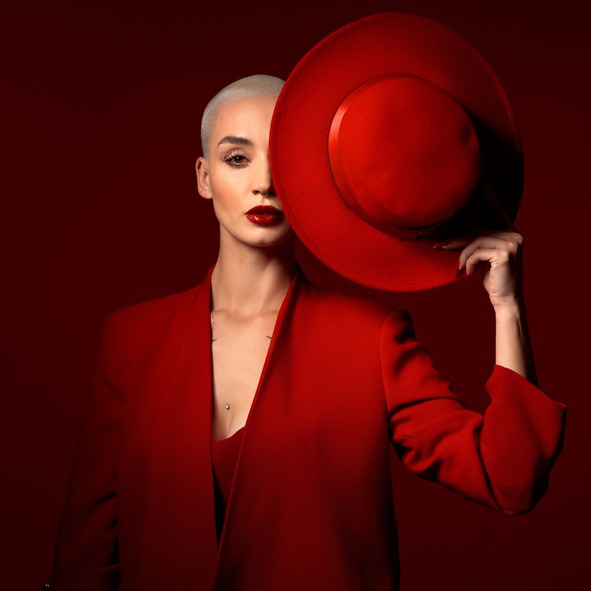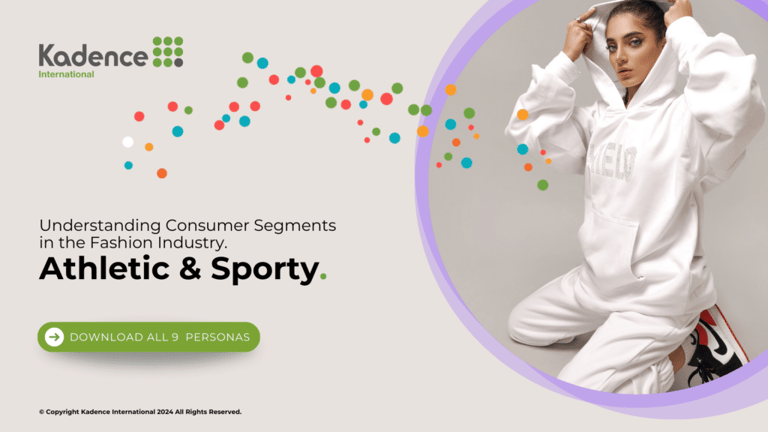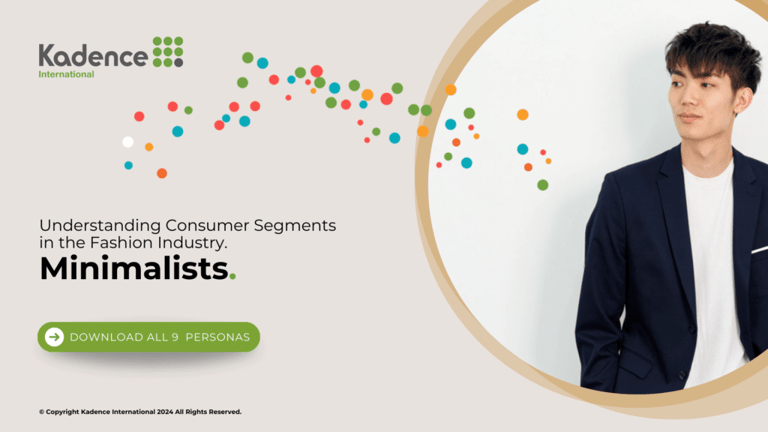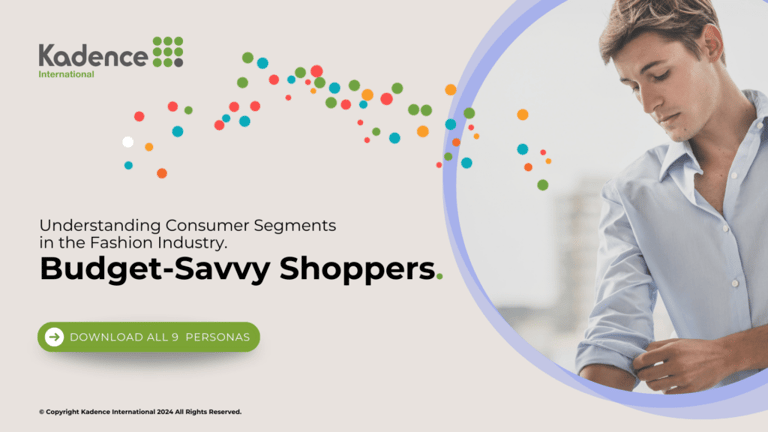The streets of Milan during Fashion Week echo the vibrancy of an industry that never ceases to evolve. The fashion industry, constantly on the move, shapes and reshapes the way we perceive style, leaving an indelible mark with each new trend. It’s a world where the bold lead and the rest follow, where what was en vogue yesterday may be passé today.
The rapid change in fashion trends can be exemplified by the resurgence of 90s aesthetics in recent years. What was once considered outdated —the oversized jackets, mom jeans, and vibrant neon colors have found their way back to the runway, embraced by a new generation. Similarly, the rise of sustainable fashion marks a significant shift in consumer consciousness, influencing major brands to rethink their strategies and designs.
Understanding these shifts is critical to creating fashion personas that resonate with the current trends that change at dizzying speeds. As we navigate the fashion runways, we must understand the many fashion buyers and their personas based on their purchasing habits, preferences, lifestyles, and motivations.
In this guide, we will explore how to harness the power of evolving trends to craft a fashion identity that is both unique and relevant. From the runways of Paris to the high street fashion in New York, let’s unravel the secrets behind creating a fashion persona that stands out in the fashion world today.
You can also download our guide here for a detailed look at 9 Types of Fashion Buyers in 2024 and beyond.
The global fashion industry is valued at $1.7 trillion, with the US alone accounting for $343.70 billion.
Fashion has moved online.
The shopping cart has increasingly shifted online. With retail e-commerce sales hitting trillions worldwide, the fashion world has unmistakably woven into daily life’s fabric.
In 2023, the global fashion e-commerce sector is set to be valued at more than 820 billion US dollars, potentially crossing the 1.2 trillion US dollar mark by 2027.
While apparel dominates online purchases, accessories and footwear also claim substantial shares of the global online fashion revenue.
Brands today are marketing sustainability, as highlighted by 66% of global millennials opting for sustainable brands even at premium prices.
However, despite its glitz and glamor, the fashion industry grapples with challenges —from the sustainability of fast fashion to ethical manufacturing and more.
The State of the Fashion Industry: Resilience, Challenges, and Emerging Trends
In 2022, the fashion industry demonstrated remarkable resilience, echoing its previous year’s performance. According to the McKinsey Global Fashion Index, the industry nearly matched its record economic profit from 2021.
The luxury sector led this robust performance, which saw a significant 36% rise in economic profit, counterbalancing softer segments. Even non-luxury sectors outperformed their long-term averages. The fashion industry in 2022 accrued more than double the financial profit of any year between 2011 and 2020, barring one indicative of solid margin performance.
2023: A Year of Persistent Challenges
2023 presented persistent and deepening challenges for the fashion industry. Europe and the United States experienced sluggish growth, while China’s initially strong performance diminished in the year’s second half. The luxury segment, initially resilient, began to feel the impact of weakened demand, leading to slowing sales and uneven performance.
The ever-evolving fashion buyer
The fashion industry has always been dynamic, reflecting cultural shifts, societal values, and individual identities. Yet, one of its most profound evolutions hasn’t been just in the clothes we wear but in how we buy them. As the fashion world has spun forward, the way we engage with it has transformed, primarily influenced by the rapid growth of technology. To fully grasp this metamorphosis, let’s journey through time, from the intimate boutiques of yesteryears to today’s digital storefronts.
Imagine it’s the early 1970s. Meet Eleanor, a fashionable woman in her mid-20s. Shopping for Eleanor was a tactile, almost ceremonial experience. She’d stroll down to her local boutique or department store when she needed a new dress. She’d greet the store owner, perhaps even by first name. She’d touch the fabrics, try on various outfits, and often chat with other shoppers, making it a social experience. Personal recommendations, trust in local shopkeepers, and word-of-mouth drove her buying decisions.
Catalogs played a role, too, especially for those living further from urban centers. This was an era where shopping was as much about community as it was about consumption.
Fast forward to the 1990s, and meet Eleanor’s daughter, Lisa. While local stores still held their charm, shopping malls became the new house of fashion. Lisa would spend hours with her friends, hopping from one brand to another under one roof. Advertisements on TV, magazines, and billboards influenced her choices. The rise of chain stores meant she had access to global brands, allowing her to tap into broader trends. Yet, the most significant change was looming on the horizon: the dawn of the internet.
Now, step into the present and meet Zoe, Lisa’s tech-savvy daughter. For Zoe, shopping is literally at her fingertips. Through her smartphone, she can access any brand, anywhere in the world, at any time. Influences come from social media content, online reviews, and digital advertising. Algorithms curate personalized shopping experiences for her, and Augmented Reality lets her ‘try on’ clothes without ever stepping into a physical store. While she might still enjoy a day out shopping with friends, many of her buying decisions are shaped online, emphasizing the power and reach of digital platforms in today’s retail world.
This evolution from Eleanor to Zoe isn’t just about changing shopping venues; it’s about shifting mindsets, influences, and expectations. Fashion buying has been interwoven with technological advancement and cultural change, making understanding the consumer more critical than ever.
In the following sections, we’ll dive deeper into the role of consumer personas, like Eleanor, Lisa, and Zoe, and explore how they help the fashion industry navigate this intricate landscape.
Brands face the dual challenge of sustainability awareness and the urgency to reduce landfill waste.
In crafting effective fashion personas, it’s essential first to comprehend the many challenges the fashion industry encounters. This understanding is pivotal for grasping the evolving ecosystem in which these personas operate and interact.
Much like character studies in a novel, fashion personas are deeply influenced by the industry’s dynamics —from sustainability efforts to digital transformations. Recognizing these challenges helps marketers appreciate the context in which fashion personas evolve, adapt, and thrive.
The sustainable fashion industry is valued at over $6.5 billion and is expected to reach $15 billion by 2030.
The fashion industry is undergoing significant transformations due to challenges encompassing a range of environmental, economic, and social issues.
Major Challenges Facing Fashion Brands
Environmental Impact and Sustainability Challenges
Transition to Eco-Friendly Materials: Transitioning to sustainable materials like organic cotton, recycled polyester, and Tencel is imperative but expensive and demands new manufacturing processes. Reducing harmful chemicals in textile production is also a priority.
Supply Chain Transparency: Achieving transparency and traceability in the supply chain is challenging. Consumers increasingly demand information about product origins, working conditions, and environmental impacts.
Textile Waste and Circular Fashion Model: The industry must address textile waste through recycling and reuse. Adopting a circular fashion model, which involves designing easily disassembled and recycled products, is essential to reduce waste.
Reducing Carbon Emissions: The fashion industry, contributing around 10% of global carbon emissions, is under pressure to reduce its carbon footprint across the supply chain, from raw material production to garment manufacturing and transportation.
Eliminating Toxic Chemicals and Microplastics: Addressing toxic chemicals and microplastics in clothing production is crucial for human health and environmental protection.
Developing Climate Change Resilience Plans: Adapting to the impacts of climate change requires a comprehensive approach across the entire supply chain.
Economic and Market Challenges
Economic Uncertainty: The industry faces macroeconomic tensions and a potential global recession, with inflation causing rising costs and potential consumer spending decreases.
Inventory and Returns Management: Efficiently managing inventory and returns is crucial to address changing consumer habits and minimize waste and decreased profitability.
Competition from Fast Fashion: Fast fashion and off-price retailers, offering trendy and affordable clothing, challenge traditional brands. Competing requires a focus on quality, sustainability, and innovation.
Rethinking Sales Strategies: Rethinking discounting and sales strategies is necessary to maintain profitability and manage inventory effectively.
Growth in Rental and Resale Models: The growing rental and resale markets offer opportunities for brands to invest in and promote sustainability.
Social and Labor Challenges
Labor Rights and Fair Wages: Ensuring fair wages and improving labor rights and workplace conditions are essential. This includes addressing long hours, unsafe conditions, and harassment.
Advancing Diversity and Inclusion: Promoting diversity, equity, and inclusion in the workforce is necessary to provide equitable employment opportunities.
Talent Shortage and Skills Gap: The industry faces a talent shortage and skills gap, affecting innovation and competitiveness. Attracting and retaining talent, reskilling for digital transformation, and investing in upskilling are crucial.
Challenges arising from Digital Transformation
Adopting E-Commerce and Omnichannel Models: E-commerce growth and the need for omnichannel retail models are reshaping the industry. Brands must meet the increasing demand for seamlessly integrating offline and online shopping experiences.
Leveraging Digital Marketing: Utilizing digital marketing and social media influencers is becoming increasingly vital for brand awareness and sales.
Exploring Innovations: Innovations like virtual try-ons and the metaverse are emerging as influential factors in the fashion industry.
How Fashion Personas Help Brands Understand What Their Customers Want
As brands jostle for attention in an oversaturated market, the key to success is resonating with the right audience. This is where fashion personas, like Eleanor, Lisa, and Zoe, from our example, come into play.
But what exactly are these personas, and how do they steer a brand’s strategy?
1. Defining Fashion Personas:
A fashion persona is a detailed representation of a specific segment of a brand’s target audience. More than just a demographic breakdown, it encapsulates preferences, shopping behaviors, values, challenges, and even aspirations. These personas are like fictional characters, crafted using market research, data analytics, and, sometimes, a dash of intuition.
2. A Mirror to Consumer Desires:
Fashion personas act as mirrors, reflecting what consumers seek. By understanding the likes and dislikes of ‘Athleisure Annie’ or the values and challenges of ‘Sustainable Sam,’ brands can curate collections, marketing campaigns, and even in-store experiences that cater to these needs. It eliminates the guesswork, ensuring every decision, from the fabric chosen to the style promoted, and the message resonates with the intended audience.
3. Crafting Tailored Narratives:
With personas, brands can craft narratives that speak directly to their audience. For example, knowing that “Retro Rita” values nostalgia and the history of fashion allows brands to weave stories that tug at these sentiments. This results in advertising campaigns, social media content, and even runway themes that feel personal and engaging.
4. Predicting and Adapting to Trends:
Fashion is notorious for its ever-changing trends. However, brands can stay ahead with a keen understanding of their consumer personas. By monitoring the evolving preferences of their key personas, brands can predict emerging trends, ensuring they’re not just keeping pace with the industry but leading it.
5. Enhancing Customer Loyalty:
When consumers feel seen and understood, their loyalty to a brand deepens. Brands build trust by consistently delivering products and experiences that align with their personas’ desires. Over time, this translates into a dedicated customer base that doesn’t just buy but also advocates for the brand.
6. Optimizing Resource Allocation:
Understanding where to invest is crucial for brands, especially those with limited resources. Fashion personas offer clarity. If a brand knows that a significant segment of its audience mirrors “Budget Brenda,” they can prioritize affordable yet trendy collections and forgo high-end materials that might not appeal to this group.
9 Core Fashion Personas Shaping the Fabric of Retail
Let’s look at 9 fashion personas that serve as your brand’s North Star, guiding you through consumer expectations, preferences, and behaviors. They are about creating fictional characters and embedding the consumer’s voice within the brand’s strategy. In a world where personalization is paramount, and consumers crave authentic connections, these personas are the bridge between brands and their audiences.
Segment 1: Trendsetters
Overview
As their moniker suggests, trendsetters stand at the vanguard of fashion, defining and reshaping the fashion norms of the era. These individuals are not fashion followers but architects, blending their personal style with a foresight of where the industry is headed. Living in an age where boundaries between private and public lives are blurred, trendsetters wield their fashion choices as an extension of their identity.
For them, fashion is more than aesthetics—it’s a mode of communication, a means to convey their perspective, values, and individuality.
Their influence isn’t contained within the realm of apparel alone. It stretches across various domains like technology, music, art, and food. The quintessential trait of a trendsetter is their ability to spot the developing, to discern what will capture people’s attention next. They are early adopters, fearless in their choices, and often become the touchstone for others seeking direction.
While their choices might seem eclectic and unpredictable, there’s a method to the madness. Trendsetters are adept at coherently weaving diverse inspirations from high fashion runways, street style, or global cultures.
Current Trends and Impact of Trendsetters on the Fashion Industry:
- Digital First: Trendsetters are invariably digital natives. They discover the latest styles on social media platforms, from TikTok’s quick-paced style challenges to Instagram’s curated fashion shoots.
- Sustainability and Ethical Fashion: Unlike ‘fast fashion,’ many trendsetters now advocate for sustainable fashion. It’s chic to be sustainable, and brands that promote ethical sourcing and production are gaining traction.
- Cultural Fusion: There’s a blend of global cultures in their wardrobe. Whether it’s the Japanese kimono-inspired jackets or African print dresses, it’s about blending borders seamlessly.
The impact of trendsetters on the fashion industry is significant. Their choices can make or break brands. Their endorsement brings legitimacy, and their critique can push brands to re-evaluate their offerings.
Segment 2: Classic Traditionalists
Overview
As fashion trends come and go with blinding speed, the Classic Traditionalists stand as pillars of timeless style. These individuals resonate with fashion that transcends seasons and fleeting trends. They embody the adage, “Fashion fades, style is eternal.” Drawing inspiration from eras where every garment was a statement of elegance and poise, Classic Traditionalists often gravitate toward attire that has withstood the test of time.
They are often seen as the antidote to today’s frenzied fashion cycles, preferring quality over quantity. Their choices are a harmonious blend of the past and the present, creating a style that feels both familiar and fresh. By interweaving contemporary nuances with classic elements, they create looks that exude sophistication and self-assuredness.
While they may appear resistant to change, it’s not about aversion but discernment. They meticulously select pieces that complement their curated wardrobe, ensuring every addition has a sense of purpose and longevity.
Current Trends and Impact of Classic Traditionalists on the Fashion Industry:
- Tailored Fit: The importance of a well-fitted garment cannot be overstated for Classic Traditionalists. Precision is vital because there’s a noticeable move toward bespoke and tailored clothing.
- Neutral and Earth Tones: While bold colors have their moments, Classic Traditionalists often lean toward neutral palettes – beiges, navies, whites, and grays that offer versatility.
- Quality Fabrics: Silk, wool, and organic cotton are materials of choice, emphasizing durability and comfort.
Their preferences are pivotal in ensuring the fashion industry keeps in touch with its roots. The sustained demand for classic pieces ensures that brands balance innovation and tradition.
Segment 3: Eco-Conscious Shoppers
Overview
Eco-conscious shoppers emerge from an intersection of style and sustainability. This segment believes that fashion should not come at the planet’s or its inhabitants’ expense. While their predecessors might have prioritized the look and feel of garments, these individuals weigh their purchases’ ethical and environmental implications just as heavily. Their commitment goes beyond mere labels; it’s about tracing the entire journey of a garment, from the raw material sourcing to the conditions under which it was produced.
This segment does not view sustainability as a passing trend or a niche; instead, it’s an indispensable facet of their purchasing philosophy. In an age where the environmental impact of industries is exposed, these shoppers make informed, intentional choices in harmony with their values. Their wardrobe reflects the world they envision —one where style and sustainability coexist seamlessly.
Current Trends and Impact on the Fashion Industry:
- Transparency: Eco-conscious shoppers seek brands that offer complete transparency about their supply chains and manufacturing processes.
- Upcycling and Circular Fashion: This segment shows a keen interest in brands repurposing materials, thereby reducing waste.
- Plant-Based Materials: Materials like hemp, bamboo, and organic cotton are in demand due to their low environmental impact.
Their purchasing behavior has nudged the industry toward a more sustainable course. Brands are now investing in eco-friendly materials, ethical labor practices, and sustainable packaging in response to the demands of this segment.
Segment 4: Luxury Enthusiasts
Overview
Luxury Enthusiasts are connoisseurs of exclusivity, craftsmanship, and heritage. For them, fashion is an art form, an experience, a reflection of a legacy often spanning centuries. Their choices aren’t driven by necessity but by a deep appreciation for the meticulous craftsmanship, unique designs, and the stories embedded in each piece. Luxury is a profoundly personal journey of aligning with brands that echo their values and aspirations.
Positioned at the apex of the fashion hierarchy, Luxury Enthusiasts are pivotal in setting broader industry directions. Their preferences often trickle down, influencing mass-market designs and trends. They are constantly curating and refining their style, which is often bespoke, personalized, and tailored to perfection.
Current Trends and Impact of Luxury Enthusiasts on the Fashion Industry:
- Bespoke Experiences: Luxury Enthusiasts seek personalized shopping experiences beyond just clothing, from private viewings to custom fittings.
- Digital Integration: Luxury shopping is increasingly moving online, with augmented reality fittings and virtual consultations becoming standard.
- Heritage and Storytelling: Brands that have a rich history and can weave compelling stories around their products find favor with this segment.
The choices of Luxury Enthusiasts set the gold standard in the fashion industry.
Their patronage can elevate a brand to iconic status, and their critique can be a call for introspection.
Segment 5: Athletic and Sporty
Overview
This segment of Athletic and Sporty fashion enthusiasts prioritize comfort, functionality, and performance in their wardrobe choices, but not at the expense of style. This intersection of fashion-forward designs and technologically advanced materials has propelled sportswear from the confines of gyms to mainstream streets, workplaces, and social settings. “Athleisure,” a term now ubiquitously used, epitomizes this merger of athletic apparel with everyday wear, highlighting the evolution of sportswear into a lifestyle.
The rise of this segment spotlights a broader societal shift toward health, fitness, and overall well-being. This demographic is not solely composed of athletes or fitness enthusiasts but is increasingly embraced by individuals seeking versatile attire that aligns with their active, on-the-go lifestyles. This fusion of comfort and style underpins the segment’s universal appeal.
Current Trends and Impact of Athletic and Sporty Personas on the Fashion Industry:
- Tech-infused Apparel: Clothing integrated with tech features, like moisture-wicking, breathable fabrics, and even embedded sensors for tracking physical metrics, is gaining traction.
- Versatility: Multipurpose clothing that can transition from a workout session to a casual outing is in high demand.
- Sustainable Sportswear: Eco-friendly materials and ethical manufacturing in the sportswear segment attract this group’s eco-conscious subset.
The Athletic and Sporty trend has democratized sportswear, making it a staple for diverse demographics. Brands traditionally not in the sportswear domain are collaborating or launching their athleisure lines, reflecting the segment’s industry-wide influence.
Segment 6: Bohemian Romantics
Overview
The Bohemian Romantics are a breed apart in the fashion world, exuding an eclectic blend of vintage, ethnic, and uninhibited style. They aren’t just donning garments but curating stories, drawing from global influences, eras, and personal experiences. Their wardrobe choices are less about fitting into a mold and more about self-expression, liberation, and embracing the unconventional.
This segment’s fashion is characterized by its free-spirited aesthetic, harmonizing rich textures, layered garments, earthy tones, and artisanal details. It’s a rebellion against the structured and the mainstream, a nostalgic nod to the days of Woodstock, and a tribute to artisan communities worldwide.
Current Trends and Impact of Bohemian Romantics on the Fashion Industry:
- Global Fusion: A blend of cultures and traditions, often showcased through embroidery, prints, and jewelry.
- Sustainable and Artisanal: A tilt toward slow fashion, with handmade, upcycled, and ethically sourced pieces in the spotlight.
- Mix and Match: A juxtaposition of vintage finds with contemporary pieces, creating a unique style language.
The influence of the Bohemian Romantics has led to the resurgence of craft-based techniques, emphasizing the narrative and the hands behind the piece rather than mass-produced fashion. Their impact is evident in seasonal collections where boho-chic elements often find prominence, reflecting the segment’s influence even in mainstream fashion.
Segment 7: Minimalists
Overview
Minimalists stand out as a refreshing voice of simplicity and intentionality. This segment seeks purity in design, valuing function as much as form. A Minimalist’s wardrobe is characterized by its neutral palette, clean lines, and timeless pieces that effortlessly blend, representing a conscious departure from the frenetic cycle of fast fashion.
For Minimalists, less is indeed more. They prioritize quality over quantity, investing in versatile pieces that serve multiple purposes rather than fleeting seasonal trends. Their clothing choices reflect a holistic lifestyle that appreciates subtlety, embraces sustainability, and rejects the noise of overconsumption.
Current Trends and Impact of Minimalists on the Fashion Industry:
- Capsule Wardrobes: Curating a limited set of interchangeable garments that can create multiple outfits, emphasizing doing more with less.
- Sustainable Fabrics: A gravitation toward organic, sustainable, and long-lasting materials that align with the Minimalist ethos.
- Neutral and Earthy Tones: Dominance of monochromatic shades, beige, white, black, navy, and muted earthy hues.
The Minimalist approach has steered the fashion industry toward sustainable practices, highlighting the need for quality, longevity, and ethical production.
It’s a pushback against the disposability culture, prompting brands to re-evaluate their production practices and design philosophies.
Segment 8: Budget-Savvy Shoppers
Overview
Amid the dazzling allure of luxury labels and high-end boutiques, Budget Savvy shoppers navigate the fashion industry with a sharp eye for value. Driven by fiscal prudence, they seek style without compromising their wallets. These consumers excel in balancing aesthetics with affordability, ensuring they remain stylish without breaking the bank.
Their shopping habits are characterized by strategic planning: waiting for seasonal sales, leveraging loyalty programs, and hunting for the best deals online and offline. This doesn’t mean they compromise on quality; instead, they are adept at discovering underrated brands or items that offer great value for the price. They challenge the stereotype that fashion needs to be a load on the wallet.
Current Trends and Impact of Budget-Savvy Shoppers on the Fashion Industry:
- Flash Sale Platforms: Websites and apps dedicated to limited-time offers and steep discounts on branded fashion items.
- Loyalty Programs: Brands offering points, rewards, and exclusive discounts to frequent shoppers.
- Thrift Shopping: Embracing pre-loved items from thrift stores or online platforms, further emphasizing value for money.
Budget Savvy shoppers have significantly shaped retail strategies, compelling brands to offer competitive pricing, regular promotions, and value-added services.
Their behavior has also fostered the growth of discount platforms and second-hand marketplaces, diversifying how fashion is consumed.
Segment 9: Edgy and Alternative
Overview
The Edgy and Alternative persona is a testament to the spirit of rebellion, self-expression, and defiance of the norm. This group is not content with blending into the crowd; instead, they make bold statements with their sartorial choices.
Defined by their unique tastes, they gravitate toward unconventional designs, striking patterns, and a palette that often leans into dark or vibrant hues.
Their fashion lexicon includes punk, grunge, goth, streetwear, and other subcultures, epitomizing an unapologetic departure from mainstream fashion.
While they might embrace specific trends, their primary motivation is to be authentic to their style, even if it means swimming against the popular tide.
Current Trends and Impact of the Edgy and Alternative Persona on the Fashion Industry:
- Alternative Prints and Patterns: Motifs like skulls, chains, or graffiti are becoming part of mainstream collections.
- Diverse Materials: Using leather, mesh, or PVC to create edgy silhouettes.
- Unique Accessorizing: Chokers, spiked bracelets, and platform shoes appear recurrently.
The presence of this segment has enriched the fashion industry by challenging the conventional definitions of beauty and style. It has prompted designers to experiment, take risks, and incorporate subcultural aesthetics into their collections.
The Future Outlook for Fashion Brands in 2024
An overall theme of uncertainty mirrors broader economic concerns, including subdued growth prospects, persistent inflation, and weakened consumer confidence. Fashion brands face the challenge of identifying new performance drivers amidst these conditions.
Global Economic Challenges and Consumer Shifts
Geopolitical Concerns: Geopolitics remains a top concern for fashion industry executives, influencing growth prospects and operational strategies.
Economic Volatility and Inflation: Economic instability and inflation continue to challenge the fashion industry, requiring strategic responses from brands.
Consumer Confidence and Regional Variations: Consumer spending patterns show notable regional differences, with countries like India displaying higher consumer confidence than Western nations.
Key Themes for 2024
Global Economy: The industry must navigate an unsettled global economic climate, requiring enhanced contingency planning and management for uncertainty.
Climate Urgency: Increasing extreme weather events make climate change an urgent priority, demanding immediate action in emissions reduction and supply chain resilience.
Consumer Shifts: Expectations around travel and lifestyle changes will necessitate refreshed brand distribution and category strategies.
Influencer Marketing Evolution: Brand partnerships with influencers will require new strategies, focusing on video content and creative collaborations.
Outdoor and Lifestyle Fusion: As consumers embrace healthy lifestyles, the line between outdoor functionality and lifestyle fashion will continue to blur.
Generative AI in Creativity: Gen AI’s role in enhancing human creativity will be pivotal in the fashion industry, extending beyond automation.
Fast Fashion Dynamics: The competitiveness of fast fashion is evolving, with new players challenging traditional approaches to pricing, customer experience, and speed.
Focus on Brand Marketing: Emotional connections and long-term brand building will become crucial as the industry shifts focus from performance marketing.
Sustainability Regulations: With increasing regulatory interventions, brands and manufacturers must adapt their business models to comply with new sustainability standards.
Supply Chain Volatility: The bullwhip effect in supply chains will pressure suppliers, emphasizing the need for transparency and strategic partnerships.
The fashion industry is navigating a complex landscape marked by economic headwinds, consumer shifts, and the urgent need for sustainable practices. As it adapts to these challenges, the industry’s agility and innovative capacity will be critical to its continued resilience and growth.
Download our guide here for a detailed look at 9 Types of Fashion Buyers in 2024 and beyond.











